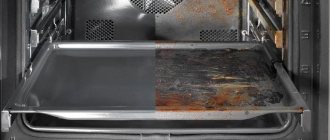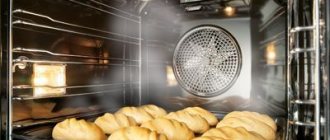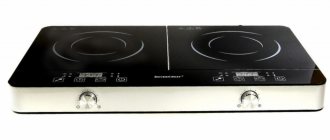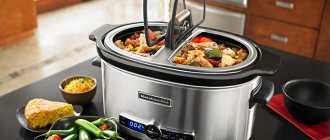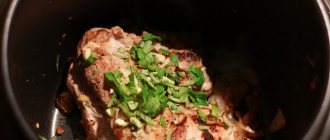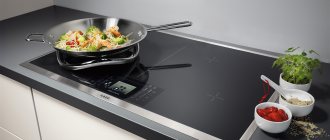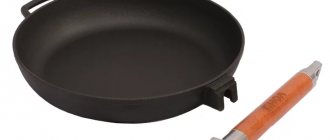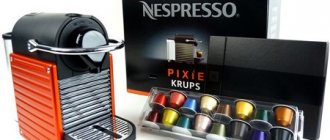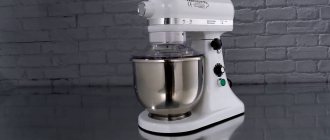What is this oven cleaning?
Hydrolysis cleaning of the oven is carried out using a specially designed powerful but gentle system, which involves the use of ordinary clean water and a special detergent. The hydrolysis process itself, as a rule, occurs at relatively low temperatures, not exceeding one hundred degrees Celsius.
Important:
Many modern models of stoves and ovens are equipped with built-in cleaning systems. In this case, it is recommended to follow the instructions for the correct use of the method. As a rule, the manufacturer indicates it in the instruction manual.
Oven cleaning systems
Next, you will be presented with a table of existing methods for cleaning ovens. Please note that the table includes key features, but how each system works is described below. We will dwell in more detail on what hydrolysis oven cleaning is.
| Cleaning type | Hydrolytic | Catalytic | Pyrolytic |
| How does it work | Steam breaks down stains and dirt into soot and water | The process of breaking down fats and other elements is carried out under the influence of catalysts that are present in the pores of the enamel. The enamel, in turn, covers the side walls of the oven. | Stains and dirt turn into ashes due to thermal effects |
| Energy consumption | Minimum | Average | Maximum |
| Temperature used | 50 to 90 degrees | 140 to 250 degrees | Up to 500 degrees |
| Is intervention necessary? | + | ||
| Do parts need to be replaced? | — | Present | — |
| Using detergents | + | — | |
| Frequency of application | After every cooking | As it gets dirty | |
| Efficiency | Copes with simple, fresh stains | Copes with tough, fresh stains | Copes with stains of any complexity |
| Price | Low | Average | High |
When choosing, do not forget that each type has its pros and cons.
Mechanism of operation of the system
To begin the procedure, place a baking tray in the oven with a small amount of clean water (usually half a liter is enough), to which a special cleaning agent is added. Next, turn on the oven for half an hour, having previously set the temperature from fifty to ninety degrees Celsius.
The steam generated acts on contaminants (including stubborn and complex ones) during the washing process. Hydrolytic cleaning requires it to soften and dissolve grease and other types of tough stains.
After the action of the washing steam has passed, the remaining dirt is cleaned out manually using soft rags and medium-hard sponges. You can also use soft plastic brushes.
Important:
The use of metal brushes, spatulas and other sharp objects can damage the enamel. This will not only spoil the appearance of the product, but will also complicate further use and washing. However, equipment with enamel panels can greatly facilitate the process of manual cleaning.
Aqua Clean option
It features the ability to clean the oven at low temperatures. To start the function, a temperature of 50 degrees is enough. It is allowed to use both special liquid and ordinary water. The program starts for exactly half an hour. The system automatically switches off and the oven can be opened.
Further actions are similar. First, the surface is thoroughly wiped, and then the oven door is opened slightly and the excess liquid is allowed to evaporate. Close the household appliance after about an hour. If the contamination is severe, it is recommended to use a special product. It removes stubborn stains better.
Advantages and disadvantages of the technique
Using the method of washing kitchen appliances is very convenient and profitable. The hydrolysis system also has the following advantages:
- Enabling the system has virtually no effect on the cost of the equipment;
- The cleaning process does not require a lot of costs;
- Washing requires a small amount of electricity.
However, like any other method, this one also has significant disadvantages:
- In advanced situations, hydrolysis practically does not help and washing requires additional effort;
- This method should be used directly on the day of cooking in the oven so that contaminants do not become embedded.
Hydrolysis or catalytic purification?
Many housewives often wonder: which oven cleaning is better - catalytic or hydrolysis? An important role in solving the selection problem is played by factors such as the degree of contamination, frequency of use of equipment and washing. However, in any case, you should also understand what a catalytic system means. Unlike the previous option, this one involves washing using chemical reactions and processes.
Main advantages of the method:
- Fat stains are easy to remove;
- It is possible to automatically turn on during operation (when the temperature rises above one hundred and forty degrees);
- It is quite easy to remove any remaining dirt after the procedure.
More details about catalytic cleaning in this article.
However, there are a number of disadvantages against which hydrolysis occupies an advantageous position:
- The cost of the system significantly increases the price of the equipment;
- Cleaning panels are not installed on the doors and bottom of the oven, so they have to be washed manually;
- When sweet and dairy products come into contact with the surface, chemical reactions are possible that complicate the cleaning process;
- Every few years the panels need to be replaced.
Hydrolysis or pyrolytic system?
Another easy way to clean an oven is pyrolysis. It is believed that it is more perfect than hydrolysis and catalytic ones. It has the following advantages:
- Dirt removal occurs due to the action of high temperatures without the use of additional means;
- Manual removal of dirt residues is ensured by its complete combustion.
But the disadvantages are also important:
- Products with the introduction of this system are much more expensive than analogues;
- Connecting high temperatures involves high power consumption;
- Strong heat can damage nearby furniture, so the oven must be insulated.
Video: pyrolytic system
Thus, it is worth noting that of all the methods offered by manufacturers, the hydrolysis method of washing can be considered the most profitable. On the other hand, it is less effective compared to other methods.
Reviews from people using the hydrolysis system
Anastasia
“The oven in our house, which was almost fifteen years old, recently broke down, and my husband and I decided to buy a new one, as modern as possible. Having saved up a little money, we went to the store and began to choose. When a female consultant approached us and offered to help us choose, she asked what kind of cleaning system we would like in our equipment. This question surprised us, since neither my husband nor I had thought about it before. But for the money, we chose an oven with hydrolysis. Of course, it is not suitable for heavy dirt, but I try to use the oven carefully, so there are no problems. In addition, it is necessary to maintain hygiene and allowing oily deposits to develop is very harmful. Moreover, the accumulation of such dirt seriously spoils the appearance of appliances and the kitchen, and this encourages cleaning more often.”
Tatiana
“We have a large family and small children, so we have to cook a lot and often, including baked goods, desserts, puddings, and baked meats. In the old oven, this was made more difficult by the fact that it had to be constantly washed. Moreover, not every stain was easy to clean. After reading reviews on the Internet, we decided to buy a new one with a hydrolysis system and were very pleased with the purchase. It’s convenient and practical, and most importantly inexpensive.”
Michael
“We have been using a stove and oven with a hydrolysis cleaning system for two years now and cannot be happier with it. We rarely cook because we are practically never at home, so we often don’t have to clean. And for lack of time, wash the oven. Therefore, the above system makes life much easier for our family. Recently, my daughter became interested in cooking and began preparing to enter a culinary college. I mastered the easy washing method quite quickly.”
Video: tips from the seller:
The principle of hydrolysis purification
It is no coincidence that hydrolysis oven cleaning received such a name, because it is based on the process of hydrolysis (decomposition) - a chemical reaction in which substances interact with water, break down and form new compounds. So, the essence of cleaning is as follows:
- Water is poured into a special oven tray, the door is closed, and the appliance is heated to a temperature of 90 °C.
- When the oven heats up, the water heats up and produces steam. It will soften dried grease stains and other contaminants.
- The marked fat will drain to the bottom of the oven and must be removed manually after the oven has cooled, which will take 30-40 minutes.
The internal surfaces of ovens with a steam cleaning method are coated with a special easy-to-clean enamel that is resistant to food acids. This protective coating is necessary to prevent particles of fat and other contaminants from penetrating into the oven.
When purchasing an oven, choose those models that have enamel that can prevent the accumulation of fat. This will greatly facilitate hydrolysis cleaning in the future.
The following video shows you how steam cleaning of an oven works:
This function cannot be called automatic, since after it you still have to use a damp cloth. To prevent cleaning from taking a lot of time and effort, the oven should be cleaned as often as possible, preferably after each cooking.
